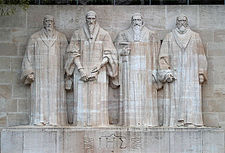Alexander Henderson | |
|---|---|
 | |
| Born | c. 1583 Guthrie, in the Fife parish of Creich |
| Died | 19 August 1646 Edinburgh, Scotland |
| Occupation(s) | Pastor, author, reformer |
| Notable work | The Government and Order of the Church of Scotland (1641)[1] |
| Spouse | none |
| Theological work | |
| Tradition or movement | Presbyterianism |
| Part of a series on |
| Reformed Christianity |
|---|
 |
|
|
Alexander Henderson (c. 1583 – 19 August 1646) was a Scottish theologian, and an important ecclesiastical statesman of his period. He is considered the second founder of the Reformed Church in Scotland. He was one of the most eminent ministers of the Church of Scotland in the most important period of her history, namely, previous to the middle of the seventeenth century.[2]
Alexander Henderson was born in 1583, and studied at the University of St. Andrews. He was, through the influence of Archbishop Gladstanes, presented to the church living of Leuchars, Fifeshire, and was in 1615 inducted forcibly into the charge. He was then a supporter of episcopacy; he subsequently changed his views and became a zealous upholder of Presbyterianism. He opposed the adoption of the Five Articles of Perth in 1618, and resisted the use of the Scottish Prayer Book in 1637.
He drafted both the National Covenant of 1638 with Archibald Johnston, Lord Warriston, and the Solemn League and Covenant of 1643.[3] He preached in the Greyfriars church on 28 February 1638, when the National Covenant was signed, and presided as Moderator of the memorable General Assembly held at Glasgow in the following November. On two subsequent occasions he was chosen Moderator of Assembly. He was Rector of Edinburgh University, and instituted a Professorship of Oriental Languages in that seat of learning. With a view to conciliate the Presbyterians, Charles I appointed him his chaplain on his visit to Scotland in 1641.
Henderson was entrusted with various important missions; he was one of the commissioners who represented the Scottish Church at the Assembly of Divines at Westminster, and he was honoured with several interviews by Charles I when he endeavoured, though unsuccessfully, to bring the king over to Presbyterianism.[3] He died at Edinburgh on 19 August 1646. At the Restoration the inscriptions on his tombstone were obliterated; they were restored at the Glorious Revolution.
- ^ Henderson 1641.
- ^ Anderson 1877, p. 454.
- ^ a b Macleod 2000, p. 1.